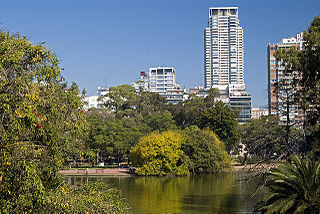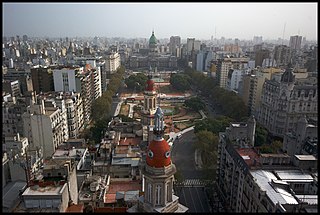

Parque Centenario is an extensive public park in the Caballito district of Buenos Aires, Argentina.


Parque Centenario is an extensive public park in the Caballito district of Buenos Aires, Argentina.
Presiding over a rapidly expanding city, the Buenos Aires City Council in 1908 approved the purchase of a 10 hectare (25 acre) plot belonging to Parmenio Piñero, a local brickmaker, for the purpose of a creating a "Westside Park" (the area was near Buenos Aires' western limits at the time). The project was entrusted to the City Parks Administrator, the renowned French Argentine urbanist Charles Thays, who completed the project in time for the 1910 centennial of the May Revolution (hence the park's name, Centenario). Rerouting two streets, Thays created a circular green space anchored by fountain in the middle. The outer sections of the park were planned for residential development, though these plans were later rescinded. [1]


The outermost lots were made available to a number of cultural and scientific institutions, notably the Louis Pasteur Institute (founded in 1927), the Marie Curie Oncological Institute (1931), the Bernardino Rivadavia Natural Sciences Museum, which relocated there from its original building in 1937, and the Argentine Friends of Astronomy Association, who opened their observatory at the park in 1944; the Leloir Institute - one of the nation's leading biotechnology research centers - and the Central Naval Hospital were both opened during the early 1980s in lots facing the park. President Juan Perón had the central fountain replaced in 1951 by an amphitheatre with a capacity for 20,000 spectators, a structure lost to arson in 1959. Mayor Osvaldo Cacciatore had a shallow lake built over 2000 m2 (21,000 ft²) of the central section of the park during the late 1970s, later populated with ducks, swans and other waterfowl. The mile-long perimeter became a popular joggers' route and a number of important public institutions had been opened along the park's surroundings. [1]
Parque Centenario increasingly suffered from neglect during the 1980s, a trend underscored by the 1989 theft of the iconic bronze female nude in sculptor Luis Perlotti's Fountain of the Irupé Flower. Mayor Aníbal Ibarra initiated an ambitious restoration project for the park in 2005, resulting in the reconstruction of the amphitheatre, the refurbishment of the swan lake and the creation of a number of new facilities. The park's refurbishment was concluded in May 2009, and the new, 2,000 seat amphitheatre was inaugurated with a performance by the City Tango Orchestra. [2] Mayor Mauricio Macri's decision to install a perimeter fence around the park in 2013, however, resulted in a violent protest by opponents of the plan. [3]

Carlos Thays was a French-Argentine landscape architect, and a student of French landscape architect Édouard André.

Agronomía is a barrio or district in the centre part of City of Buenos Aires, Argentina. It gets its name from the University of Buenos Aires Faculty of Agronomy based in the neighborhood. Its boundaries are Avenida San Martín, Campana, Avenida Salvador María del Carril, Avenida de los Constituyentes, and Avenida Chorroarín.

Caballito is a barrio (neighborhood) of the Argentine capital, Buenos Aires. It is the only barrio in the administrative division Comuna 6.

Parque Tres de Febrero, popularly known as Bosques de Palermo, is an urban park of approximately 400 hectares located in the neighborhood of Palermo in Buenos Aires, Argentina. Located between Libertador and Figueroa Alcorta Avenues, it is known for its groves, lakes, and rose gardens.

Parque Patricios is a barrio located on the southern side of Buenos Aires, Argentina belonging to the fourth comuna.

The Buenos Aires Botanical Garden is a botanical garden located in the Palermo neighborhood of Buenos Aires in Argentina. The garden is triangular in shape, and is bounded by Santa Fe Avenue, Las Heras Avenue and República Árabe Siria Street.

The Parque de la Ciudad is a former amusement park in the Villa Soldati neighborhood of Buenos Aires, Argentina.

Avenida Figueroa Alcorta is a major thoroughfare in Buenos Aires, Argentina, with a length of over 7 km (4.3 mi) along the city's northside.

Lezama Park is a public park in the San Telmo district of Buenos Aires, Argentina.

Congressional Plaza is a public park facing the Argentine Congress in Buenos Aires. The plaza is part of a 3 hectare open space comprising three adjoining plazas to the east of the Congress building. The Kilometre Zero for all Argentine National Highways is marked on a milestone at the Plaza.

Avellaneda Park is a public park in Buenos Aires, Argentina. It is located at the heart of the Parque Avellaneda neighbourhood, which takes its name from the park.

The Palacio Duhau - Park Hyatt Buenos Aires is a five star establishment located in the city's Recoleta section.

Chacabuco Park is a public park in the Parque Chacabuco section of Buenos Aires.

Avenida Leandro N. Alem is one of the principal thoroughfares in Buenos Aires, Argentina, and a commercial nerve center of the city's San Nicolás and Retiro districts. It joins Avenida del Libertador and Avenida Paseo Colón, its northern and southern continuation respectively.

The Argentina Centennial was celebrated on May 25, 1910. It was the 100th anniversary of the May Revolution, when viceroy Baltasar Hidalgo de Cisneros was ousted from office and replaced with the Primera Junta, the first national government.

The Bosch Palace is an architecturally significant residence in the Palermo section of Buenos Aires, Argentina.
Parque de la Costa is an amusement park located in Tigre, a northern suburb of Buenos Aires, Argentina.
Parque Indoamericano is a park in the Villa Soldati and Villa Lugano neighbourhoods of Buenos Aires, Argentina. It covers approximately 130 hectares, and is thus the second-biggest park in the city.

The Italpark was a theme park in Argentina, which was located where currently is the Parque Thays in the Recoleta neighbourhood of Buenos Aires. It became a landmark of Buenos Aires in its 30 years of existence.

Sonia Berjman is an urban and landscape historian, researcher on the history of Buenos Aires public space and protector of parks, squares, and public green spaces of that city, she is a acknowledged referent for these issues.